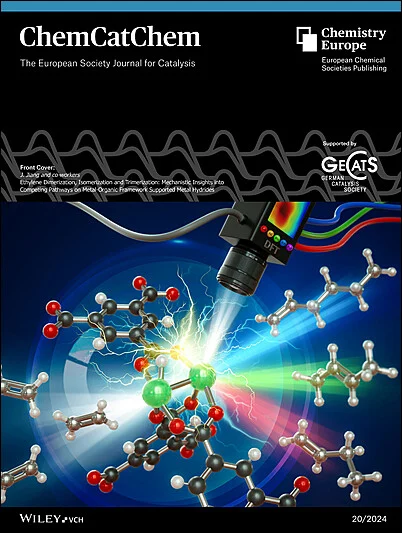通过气相辅助π共轭修饰氮化碳实现表面纳米结,从而提高光催化水分离效果
IF 3.8
3区 化学
Q2 CHEMISTRY, PHYSICAL
引用次数: 0
摘要
氮化碳(CN)的可见光收集能力不强、电荷分离速度慢、实用表面积有限,这些都制约了其在光催化水分离和环境修复方面的性能。在此研究中,通过接枝对氨基苯氧基基团对氮化碳进行热蒸汽辅助π-共轭改性,以调整氮化碳的光物理性质,从而提高其光催化活性。除了扩大光吸收外,表面改性还在深度方向上构建了一个纳米结,从而促进了电荷分离和转移。此外,热气相改性工艺将原始 CN 热蚀和修整为高孔状结构,使其比表面积增加了 10 倍。光催化结果表明,所获得的改性氯化萘在光催化水分裂过程中产生氢气的速率为 7.82 mmol/g/h,是原始氯化萘的 7 倍多,在 400 纳米波长下的量子产率为 3.28%。π-共轭修饰的氯化萘还显示出更强的光催化环境修复应用能力,例如盐酸四环素的光降解速度更快。这项工作提供了对氯化萘进行热气化表面化学修饰的综合途径,使其具有多种有利的光物理性质,从而实现高效光催化应用。本文章由计算机程序翻译,如有差异,请以英文原文为准。
Surface Nanojunction Enabled by Vapor‐Assisted π‐Conjugation Modification of Carbon Nitride for Enhanced Photocatalytic Water Splitting
The unsatisfied visible light harvesting, slow charge separation, and limited practical surface area of carbon nitride (CN) constrain its performance in photocatalytic water splitting and environmental remediation. Herein, the thermal vapor‐assisted π‐conjugation modification of CN by grafting with p‐aminophenoxy groups was developed to tune the photophysical properties of CN to enhance its photocatalytic activity. Besides extending the light absorption, the surface modification constructed a nanojunction across the depth direction, which leads to facilitated charge separation and transfer. In addition, the thermal vapor modification process thermally etches and trims the pristine CN to be highly holey structure, resulting to >10 times increase in specific surface area. Photocatalysis results showed that the obtained modified CN yielded hydrogen from photocatalytic water splitting at a rate of 7.82 mmol/g/h, over 7‐folds as that of pristine CN, with quantum yield of 3.28% at 400 nm. The π‐conjugation modified CN also demonstrated enhanced photocatalytic environmental remediation application, exemplified by much faster photodegradation of tetracycline hydrochloride. This work provides the thermal vapor surface chemical modification of CN as a promising integrated pathway of multiple favorable photophysical properties towards efficient photocatalysis application.
求助全文
通过发布文献求助,成功后即可免费获取论文全文。
去求助
来源期刊

ChemCatChem
化学-物理化学
CiteScore
8.10
自引率
4.40%
发文量
511
审稿时长
1.3 months
期刊介绍:
With an impact factor of 4.495 (2018), ChemCatChem is one of the premier journals in the field of catalysis. The journal provides primary research papers and critical secondary information on heterogeneous, homogeneous and bio- and nanocatalysis. The journal is well placed to strengthen cross-communication within between these communities. Its authors and readers come from academia, the chemical industry, and government laboratories across the world. It is published on behalf of Chemistry Europe, an association of 16 European chemical societies, and is supported by the German Catalysis Society.
 求助内容:
求助内容: 应助结果提醒方式:
应助结果提醒方式:


